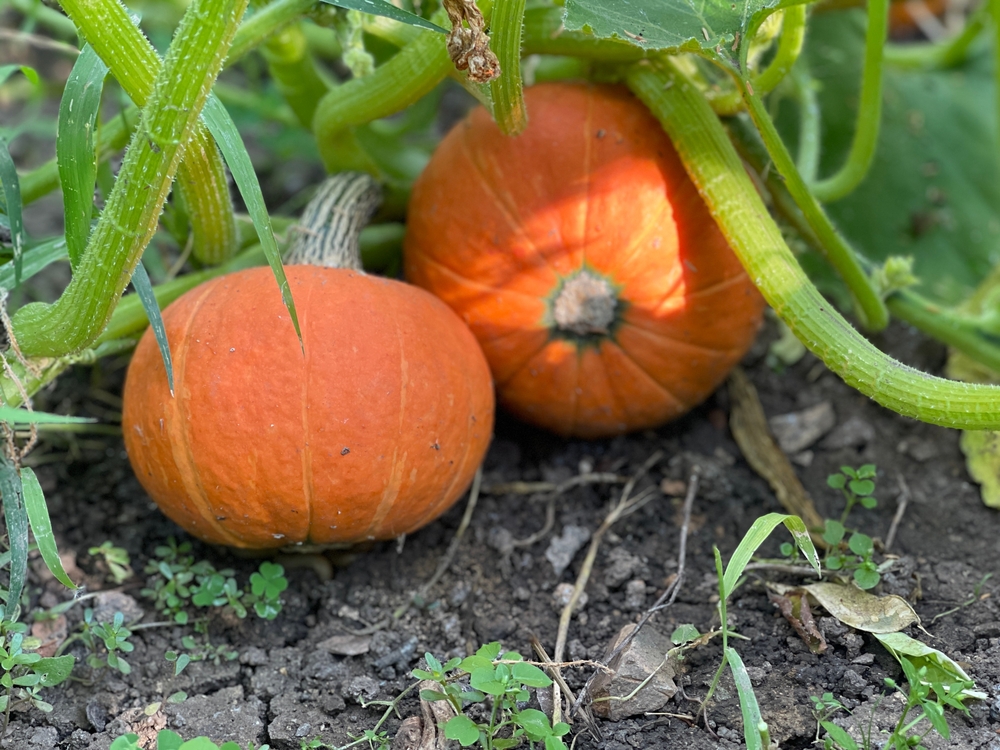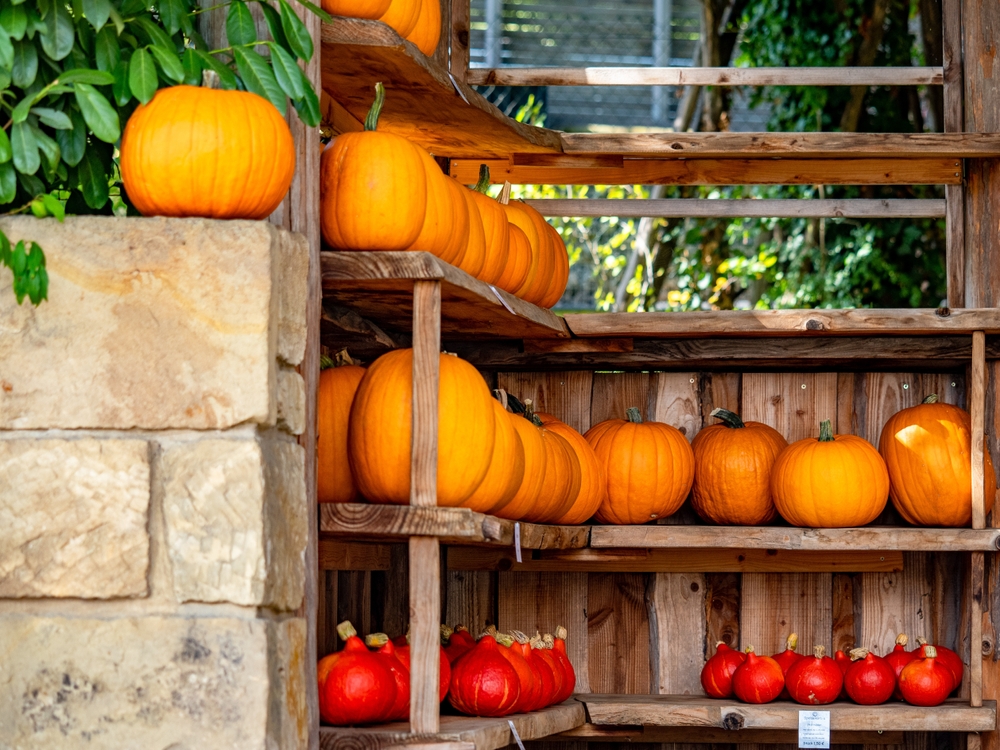
Image Source: Shutterstock.com
You picture it every year: a patch full of plump orange pumpkins, glistening in the autumn sun, ready to become pies, porch décor, or neighborhood envy. But then reality hits—your vines wither, your pumpkins stay stubbornly green, or worse, your “harvest” looks more like a sad handful of orange baseballs. Pumpkins seem simple, but they’re trickier than most gardeners expect. Behind every perfect pumpkin patch is weeks of planning, a lot of patience, and even more trial and error.
Let’s uncover the most common pumpkin-growing mistakes—and how to fix them before your next harvest turns into a Halloween horror story.
1. Planting Too Early or Too Late
Timing is everything with pumpkins. Many gardeners get overexcited and start their seeds way too soon, not realizing pumpkins are heat-loving plants that sulk in cold soil. Others wait too long, planting them just as summer starts to wind down, leaving no time for full growth. The result? Flowers that frost before fruiting or pumpkins that never turn orange. To hit the sweet spot, plant pumpkins about 90 to 120 days before your first expected frost—it’s a balancing act worth mastering.
2. Ignoring Soil Quality
Pumpkins are picky eaters with big appetites. If you plant them in poor, compacted, or nutrient-starved soil, you’re basically setting them up for disappointment. Gardeners often skip soil prep, thinking a quick sprinkle of fertilizer will do the trick—it won’t. Pumpkins need rich, well-drained soil loaded with compost or aged manure to fuel those giant vines and even bigger fruits. Think of it this way: you can’t expect a marathon runner to thrive on junk food, and your pumpkins are no different.
3. Overcrowding the Patch
It’s tempting to cram a bunch of seeds into a small space and hope for a lush, vine-filled paradise. But pumpkins are garden hogs—they sprawl, they spread, and they suffocate anything in their path. Crowded vines compete for sunlight, nutrients, and airflow, leading to weaker plants and smaller fruits. Plus, tight quarters make it easier for diseases to spread like wildfire. Give each plant plenty of space—at least six to eight feet between them—so your pumpkins can stretch out and show off.
4. Forgetting to Pollinate
You can have the healthiest vines in the world, but without pollination, you’ll never get pumpkins. Many gardeners forget that bees are essential players in this story. If your garden isn’t buzzing, your blossoms may bloom and fade without ever setting fruit. In low-bee areas, you might have to step in—literally—with a small brush to hand-pollinate. It might feel silly, but a little pollen matchmaking can make the difference between barren vines and a bountiful patch.
5. Watering Incorrectly
Pumpkins love moisture but hate soggy roots—a tricky combo for even seasoned gardeners. Too much water and you invite rot, fungus, and mildew; too little and your vines wilt into crispy ruins. The key is consistency: deep watering a couple of times a week rather than frequent shallow sprinkles. And whatever you do, avoid overhead watering—wet leaves are a playground for disease. A drip system or soaker hose will keep your pumpkins happy and your foliage dry.

Image Source: Shutterstock.com
6. Neglecting Pest Control
Ask any pumpkin grower about their greatest nemesis, and you’ll hear horror stories about squash bugs, cucumber beetles, and vine borers. These tiny terrors can devastate a pumpkin patch overnight, sucking life out of vines and chewing through stems. Too many gardeners wait until they see visible damage to take action, and by then it’s often too late. Early detection is key—inspect your plants regularly and use row covers or natural pest deterrents before problems start. A little vigilance goes a long way in saving your future jack-o’-lanterns.
7. Skipping Fertilizer (or Overdoing It)
Pumpkins are greedy feeders that need steady nutrition—but balance is everything. Many gardeners skip feeding altogether, assuming compost alone will suffice. Others go wild with fertilizer, pushing nitrogen so hard their plants grow massive vines but barely any fruit. The trick? Feed moderately and strategically. Early on, nitrogen promotes vine growth, but once flowers appear, switch to a phosphorus-rich fertilizer to encourage blooming and fruiting.
8. Forgetting to Rotate Crops
Planting pumpkins in the same spot year after year might sound convenient, but it’s a recipe for trouble. Soil-borne diseases and pests love predictable patterns—they’ll stick around waiting for next season’s feast. Many gardeners don’t realize how much damage this can cause until their plants start wilting or yellowing midseason. Rotating crops every couple of years keeps your soil healthy and your pumpkins thriving. So, give that patch a break and plant something else there next season—your pumpkins will thank you.
9. Ignoring the Leaves and Vines
Pumpkin vines are dramatic—they droop, sprawl, and sometimes look like they’re giving up entirely. But not every problem is fatal. Some gardeners panic and over-prune, cutting off healthy leaves that actually help feed the developing fruit. Others do the opposite and let vines run wild until they choke themselves out. The secret? A little tidy-up goes a long way. Trim back excessive growth, but always leave enough foliage to shade the pumpkins and fuel photosynthesis.
10. Harvesting Too Early (or Too Late)
Few moments are more satisfying than picking a perfectly ripened pumpkin—but timing it wrong can ruin the fun. Harvest too early, and your pumpkin won’t finish ripening off the vine, staying pale and soft. Wait too long, and frost or rot could claim your prize before Halloween ever arrives. The perfect pumpkin has a hard shell, deep color, and a dry, brown stem. Once you’ve found that sweet spot, cut the pumpkin with a few inches of stem attached—it’ll last longer and look picture-perfect on your porch.
Learn From the Patch and Try Again
Growing pumpkins is equal parts science, patience, and a little bit of chaos. Even the best gardeners have years when their patch flops—but every season teaches you something new. Avoiding these ten common mistakes won’t just save your harvest; it’ll turn pumpkin-growing into one of your favorite garden adventures. Whether you’re dreaming of the perfect pie pumpkin or a 50-pound porch star, remember: nature rewards persistence.
Have your own pumpkin-growing story or mishap? Share it in the comments below—we’d love to hear what your patch has taught you.
You May Also Like…
- 11 Plants That Self-Seed Perfectly in Fall
- Why Pumpkins Rot Faster if Left on Vines
- How Root Vegetables Store Nutrients Differently in Autumn
- 8 Garden Myths That Fail in Autumn Weather
- 11 Mistakes Gardeners Make When Storing Produce
Leave a Reply